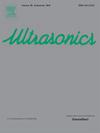基于PCS和SAFT算法的皮秒激光超声近表面微缺陷成像检测
IF 3.8
2区 物理与天体物理
Q1 ACOUSTICS
引用次数: 0
摘要
长期以来,近表面微缺陷的有效检测和成像一直是超声检测领域的关键问题。激光超声具有高分辨率和高灵敏度,是检测微缺陷的有效技术。本文通过仿真和实验研究了皮秒激光超声的时频域特性以及微缺陷与超声波的相互作用机理。利用皮秒脉冲激光在具有不同深度近表面微缺陷的样品中激发超声波,利用光学干涉仪检测传播的超声波。通过对实验结果的分析,可以检测到直径为0.13 mm,深度为0.3 mm, 0.5 mm, 1mm和2mm的近表面微缺陷。此外,提出了一种结合主成分减法(PCS)和合成孔径聚焦技术(SAFT)的缺陷成像算法,可以有效抑制瑞利(R)波干扰引起的检测盲区和伪影。与传统的水浸超声全聚焦法相比,平均信噪比提高了25.57 dB。这项研究将有助于解决产品制造和服务过程中的质量评估挑战。本文章由计算机程序翻译,如有差异,请以英文原文为准。
Picosecond laser ultrasonic imaging detection of near-surface micro defects using PCS and SAFT algorithm
The effective detection and imaging of near-surface micro defects has been the key problem in the ultrasonic inspection field for a long time. Laser ultrasound has high resolution and sensitivity which is the effective technology to detect micro defects. In this paper, the time and frequency domain characteristics of the picosecond laser ultrasound and the interaction mechanism between micro defects and ultrasonic waves are studied by simulation and experiment. A picosecond pulsed laser is used to excite ultrasonic waves in samples with near-surface micro defects of different depths, and the propagating ultrasonic waves are detected by an optical interferometer. Through the analysis of the experimental results, the near-surface micro defects with diameters of 0.13 mm and depths of 0.3 mm, 0.5 mm, 1 mm and 2 mm can be detected. In addition, a defect imaging algorithm combining principal component subtraction (PCS) and synthetic aperture focusing technique (SAFT) is proposed, which can effectively suppress the detection blind areas and artifacts caused by Rayleigh (R)-wave interference. Compared with the conventional total focusing method (TFM) of water-immersion ultrasound, the average SNR is increased by 25.57 dB. This research is poised to contribute to the resolution of quality assessment challenges in product manufacturing and service processes.
求助全文
通过发布文献求助,成功后即可免费获取论文全文。
去求助
来源期刊

Ultrasonics
医学-核医学
CiteScore
7.60
自引率
19.00%
发文量
186
审稿时长
3.9 months
期刊介绍:
Ultrasonics is the only internationally established journal which covers the entire field of ultrasound research and technology and all its many applications. Ultrasonics contains a variety of sections to keep readers fully informed and up-to-date on the whole spectrum of research and development throughout the world. Ultrasonics publishes papers of exceptional quality and of relevance to both academia and industry. Manuscripts in which ultrasonics is a central issue and not simply an incidental tool or minor issue, are welcomed.
As well as top quality original research papers and review articles by world renowned experts, Ultrasonics also regularly features short communications, a calendar of forthcoming events and special issues dedicated to topical subjects.
 求助内容:
求助内容: 应助结果提醒方式:
应助结果提醒方式:


